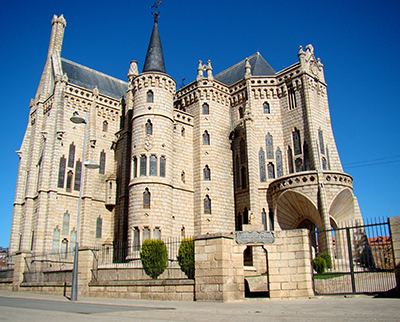The Episcopal Palace is a building that was designed by a Catalan Spanish architect called Antoni Gaudi. It is located in Astorga, in the way of Santiago. The actual building was built from 1889 to 1913 in Catalan Modernisme style. This is one of the three buildings that Gaudi worked on outside Catalonia.
At the end of the 19th century, the original Episcopal Palace in Astorga was destroyed by fire. The bishop in charge of the Roman Catholic Diocese of Astorga, Bishop Juan Bautista Grau y vallespinos, contacted Antoni Gaudi to design a new building. Antoni was his friend who he had known since he was a Vicar General, posted at the Tarragona parish. Antoni Gaudi had designed the altar of one of the churches in the parish.
Commissioning
During the time of commissioning the project, Gaudi was completing Palau Guell that was located in Barcelona. He also had the Sagrada Familia (or the holy family) to complete in the same location. For that reason, he could not travel to Astorga to determine the terrain of the location where the building would stand. Instead, the bishop sent him pictures of the area. Gaudi studied the images and created a design for the new building by the end of the year 1887. The design was consequently approved in February of 1889 by both the relevant ministry along with the Royal Academy of Fine Arts. Eventually, the construction work started in June of 1889.
The palace is built in grey granite rocks that were sourced from El Bierzo. The grey colour, as well as the neo-medieval style, was in harmony with the surroundings. Gaudi added some of the features that he was famous for that included chimneys that integrated inside facades and arches that were created at all major entrances into the palace. This palace's façade was made of four towers, shaped like cylinders and surrounded by ditches. He also created a five-metre angel to place on the roof of the façade. However, the sculpture was not mounted on the building.
Construction
This construction amounted to about 170,000 pesetas. It was a blend of seigniorial castle and bishop temple. Construction started with a basement and the ground floor started in 1890. One of the characteristics of the ground floor was a triple arc that Gaudi personally designed. However, with the death of Bishop in 1893, Gaudi has several disagreements with the council in charge of the construction and had to resign from the work. The work was left uncompleted for another decade, with various professionals unable to complete the style that was created by Gaudi.
Completion of the Building
In 1905, bishop Miranda, who was in charge of the parish, commissioned Ricardo Garcia Guereta, to complete the project. The new architect changed much of the Gaudi ideas when completing the project. The work was still going on in 1913 when bishop Alcolea consecrated the building. However, Garcia Guereta resigned from the construction of the building without finishing the last floor.
The Design of the Palace
The episcopal palace has four floors. Its interior has a deposition of a Greek cross form. Also, the chapel has a triple apse that comes with stained glass windows, gargoyles on the outside and flying buttresses. Its dining room, bishop's office and the room of the throne are organised around the lobby. Besides, it has a porch with three splayed arcs.




